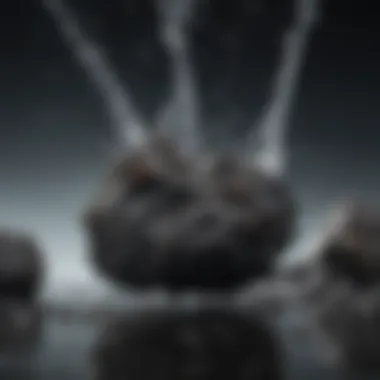Exploring the Intriguing Characteristics of Graphite: A Deep Dive into Its Unique Properties and Applications


Rock and Fossil Identification
Graphite, despite being distinct from rocks and fossils, possesses unique characteristics that make it an intriguing material to explore. Unlike traditional rocks and fossils, graphite displays a distinguished crystalline structure, which sets it apart in the world of minerals. Its layers of bonded carbon atoms create a hexagonal lattice structure, giving graphite its renowned slippery feel and excellent conductivity.
Moving on to the conductivity aspect, graphite excels in its ability to conduct electricity due to the freely moving electrons within its layers. This property makes graphite a vital component in various applications, including electrodes, lubricants, and even as a vital element in nuclear reactors. The lubrication properties of graphite result from its structure, where the weak bonds between layers facilitate smooth movements, making it an ideal choice for applications requiring low-friction materials.
Collecting Tips and Techniques
When it comes to collecting graphite specimens, enthusiasts must approach the process with precision and care. Unlike traditional rocks and fossils that can be easily identified in nature, collecting graphite requires specialized knowledge and tools. To collect graphite effectively, one must seek out prime locations rich in graphite deposits, such as metamorphic rock formations where graphite is commonly found.
To safely extract graphite specimens, collectors should use specialized tools that allow for precise removal without damaging the delicate layers of the material. Proper excavation techniques and handling are crucial to preserving the integrity of graphite samples for further analysis and study. Collectors must adhere to best practices to ensure the quality of the specimens gathered and maintain the scientific value of the collected graphite.
Preservation and Display
Preserving graphite specimens involves meticulous techniques to protect the material's integrity and prevent degradation over time. Proper storage methods, such as storing graphite samples in a dry and controlled environment away from moisture and extreme temperatures, are essential to maintaining their quality. Additionally, employing creative display ideas can enhance the aesthetic appeal of graphite specimens, allowing them to be showcased in museums, galleries, or personal collections.
Creative approaches to displaying graphite can include mounting specimens in decorative cases or incorporating them into artistic installations that highlight the unique properties of this versatile material. By blending preservation techniques with innovative display solutions, collectors can present graphite specimens in a visually engaging manner that educates and inspires viewers about the remarkable characteristics of this mineral.
Geological Insights
While graphite may differ from traditional rocks and fossils, its geological significance offers valuable insights into the Earth's natural processes. Understanding the geological formations that give rise to graphite deposits unveils the intricate interplay between pressure, temperature, and organic materials that contribute to its formation. The historical significance of graphite spans centuries, with notable discoveries of graphite deposits shaping industries and scientific advancements.
Exploring the geological aspects of graphite leads to a deeper appreciation of the mineral's role in Earth's history and the evolution of technological advancements. By delving into the geological insights provided by graphite, researchers and enthusiasts can unravel the mysteries of this extraordinary material and grasp its enduring impact on various fields of study.
Introduction
Graphite, a material of immense versatility and intrigue, offers a rich tapestry of characteristics waiting to be explored. In this article, we embark on a journey to unravel the enigmatic properties and applications of graphite, shedding light on its unique role in various industries. From its mesmerizing crystalline structure to its exceptional conductivity and lubrication properties, graphite stands as a testament to the marvels of natural materials. As we delve into the depths of graphite, we open a world of endless possibilities and applications that cater to enthusiasts, experts, and industry professionals alike.
To comprehend the true essence of graphite is to peer into the intricate framework of its atomic structure and crystal arrangement. These fundamental components provide the foundation for graphite's distinctive properties and characteristics, setting it apart as a material that defies convention and sparks curiosity. As we navigate through the nuances of graphite, we uncover a wealth of knowledge that extends beyond the surface, inviting exploration and discovery at every turn.
In our quest to understand the characteristics of graphite, we are confronted with a material that transcends the ordinary and captivates the imagination. By unraveling the mysteries of graphite, we uncover a realm of potential applications and innovative uses that continue to redefine our understanding of this remarkable substance. Join us on this fascinating journey as we delve into the depths of graphite's essence, unveiling a world of boundless opportunities and intriguing possibilities.
What is Graphite?
In the exploration of the characteristics of graphite, delving into the essence of what graphite truly is becomes pivotal. This section serves as a foundation for understanding the diverse nature of graphite and its implications across various fields. By unraveling the specific elements, benefits, and key considerations surrounding graphite, enthusiasts and experts alike can gain a more profound insight into this remarkable material.
Definition of Graphite


Graphite, a form of carbon, stands as one of the most intriguing elements in the realm of materials science. Its defining feature lies in its hexagonal crystalline structure that allows for unique properties that set it apart from other elements. Understanding the definition of graphite unveils its exceptional conductivity and thermal stability, making it a prized material in countless applications.
Atomic Structure
Within the atomic structure of graphite lies a complex arrangement of carbon atoms bonded in a hexagonal lattice. This arrangement grants graphite its distinct properties, such as its lubricity and electrical conductivity. Diving into the atomic structure sheds light on why graphite behaves the way it does in various environments, making it a subject of immense interest and study.
Crystal Arrangement
The crystal arrangement of graphite plays a crucial role in determining its physical and chemical properties. With layers of carbon atoms arranged in a honeycomb pattern, graphite exhibits properties like anisotropy and thermal conductivity. Exploring the intricacies of graphite's crystal arrangement unveils the reasons behind its exceptional versatility and widespread utility in numerous industries.
Physical Properties
Color and Luster
Color and luster are key physical properties that offer valuable information about graphite. Graphite typically exhibits a dark gray to black color, reflecting its carbonaceous composition. The luster of graphite is often described as metallic to submetallic, showcasing its ability to reflect light to a certain degree. This distinct color and luster make graphite easily recognizable and differentiate it from other materials. Understanding these visual characteristics enhances the identification and appreciation of graphite in different settings.
Density and Hardness
Analyzing the density and hardness of graphite sheds light on its solid-state properties and resilience. Graphite possesses a relatively low density compared to other materials, making it lightweight and versatile for various applications. Its hardness varies depending on the grade, with higher-grade graphite exhibiting greater hardness and durability. The unique combination of moderate density and hardness makes graphite suitable for a wide range of industrial and commercial uses, where strength and flexibility are essential.
Melting Point
The melting point of graphite is a critical physical property that influences its thermal behavior and applications in high-temperature environments. Graphite has a high melting point of around 3,550 degrees Celsius, enabling it to withstand extreme heat without degrading or melting. This exceptional thermal stability makes graphite a preferred choice for applications requiring resistance to elevated temperatures, such as in furnace linings, crucibles, and aerospace components. Understanding the high melting point of graphite highlights its resilience and versatility in demanding thermal conditions.
Chemical Properties
Chemical properties play a pivotal role in understanding the behavior and characteristics of graphite, contributing significantly to its versatility and applicability. The chemical properties of graphite encompass its reactions, composition, and potential transformations under various conditions, offering valuable insights into its stability and reactivity. By delving into the chemical properties of graphite, researchers and enthusiasts can unravel the intricate nature of this material and explore its extensive applications across diverse industries.
Chemical Composition
The chemical composition of graphite consists mainly of carbon atoms arranged in a hexagonal lattice structure, forming layers known as graphene sheets. These sheets are held together by weak Van der Waals forces, allowing them to slip past each other easily, contributing to the material's lubricity and cleavage properties. Understanding the composition of graphite is essential in comprehending its unique bonding characteristics and thermal stability, making it a preferred choice for numerous industrial applications requiring high resilience and conductivity.
Reactivity
Graphite exhibits low reactivity under normal conditions due to its stable carbon-carbon bonds, which require significant energy input to break. However, in the presence of strong oxidizing agents or elevated temperatures, graphite can undergo combustion reactions, resulting in the formation of carbon dioxide. Exploring the reactivity of graphite sheds light on its safety protocols in different environments and industries, emphasizing the importance of proper handling and storage to mitigate potential fire hazards and chemical reactions.
Oxidation


Oxidation refers to the process of graphite interacting with oxygen, leading to the formation of various carbon oxides such as carbon monoxide and carbon dioxide. The oxidation of graphite occurs gradually over time when exposed to air and moisture, resulting in changes to its surface properties and electrical conductivity. By understanding the oxidation behavior of graphite, researchers can devise strategies to enhance its resistance to environmental factors and promote its longevity in applications requiring prolonged exposure to varying conditions.
Mechanical Properties
Mechanical properties play a crucial role in understanding the behavior of graphite in various applications. Graphite's mechanical properties are essential for determining its structural integrity, strength, and overall performance. By examining these properties, researchers and engineers can assess how graphite will withstand different forms of stress and strain, making it a valuable material in numerous industries.
Flexibility
Flexibility is a key mechanical property of graphite that sets it apart from many other materials. Graphite exhibits exceptional flexibility, allowing it to bend and deform without fracturing. This characteristic makes graphite an ideal choice for applications where resilience to bending or shaping is necessary. Whether used in structural components or as a composite material, graphite's flexibility ensures durability and longevity.
Strength and Stiffness
Another vital aspect of graphite's mechanical properties is its strength and stiffness. Graphite is renowned for its high strength-to-weight ratio, making it a preferred material for industries that require lightweight yet robust materials. Its stiffness ensures dimensional stability, making it suitable for applications where rigidity is essential. The combination of strength and stiffness makes graphite a versatile material that can withstand demanding conditions while maintaining its structural integrity.
Friction and Lubrication
Furthermore, graphite's mechanical properties extend to its friction and lubrication characteristics. Graphite exhibits low friction levels, making it an excellent choice for applications where smooth movement or sliding is required. Its lubrication properties reduce wear and tear on surfaces in contact, prolonging the lifespan of components. Whether used in machinery, automotive applications, or as a solid lubricant, graphite's friction and lubrication properties contribute to enhanced performance and efficiency.
Electrical Properties
In this segment of the article, we delve into the pivotal aspect of graphite - its electrical properties. Understanding the electrical characteristics of graphite is fundamental in comprehending its versatile nature and applications. The conductivity of graphite is a standout feature that distinguishes it from other materials. Graphite's exceptional conductivity makes it an indispensable component in various industries, where the efficient flow of electricity is paramount. The high conductivity of graphite allows for the easy transfer of electrical energy, making it an ideal choice for applications where electrical connectivity is crucial.
Conductivity
Graphite exhibits remarkable conductivity due to its unique atomic structure, where electrons are free to move within its layers. This property enables graphite to conduct electricity with ease, making it an excellent choice for electrical applications requiring uninterrupted flow. The conductive nature of graphite also finds extensive use in industries such as electronics, where the efficient transmission of electrical signals is essential for optimal performance. Graphite's conductivity makes it a favored material in the production of electrical components and devices that rely on consistent electrical pathways for seamless operation.
Resistance
In contrast to its conductivity, graphite also showcases notable resistance properties. Graphite's ability to resist the flow of electrical current under specific conditions contributes to its versatility in various applications. This resistance characteristic is harnessed in applications where controlled electrical conductivity is required, allowing graphite to function effectively in different settings. Understanding graphite's resistance properties is crucial in harnessing its full potential across a spectrum of industries that rely on tailored electrical behaviors for specific requirements.
Applications in Electronics
The electrical properties of graphite play a pivotal role in its widespread applications within the electronics industry. Graphite's conductivity and resistance make it an ideal material for producing components like electrodes, circuit pathways, and battery technologies. Its versatility in conducting electricity while offering resistance when needed makes graphite an indispensable element in electronic devices and systems. Whether in consumer electronics, telecommunications, or aerospace technologies, graphite's electrical properties enhance the functionality and performance of various electronic products and technologies.
Thermal Properties
Graphite's thermal properties play a crucial role in its overall characteristics and applications. Understanding the thermal behavior of graphite is essential for various industries where heat resistance and thermal conductivity are significant factors.


Thermal Conductivity
The thermal conductivity of graphite is remarkable, making it an ideal material for applications where heat transfer is crucial. Graphite exhibits high thermal conductivity due to its unique structure, which allows the efficient transmission of heat. This property makes graphite a preferred choice in heat exchangers, thermal management systems, and other applications where thermal efficiency is vital.
Heat Resistance
Graphite's heat resistance is another distinguishing factor that sets it apart from many other materials. With its ability to withstand high temperatures without significant degradation, graphite finds extensive use in high-temperature environments. This remarkable heat resistance makes graphite a valuable material in industrial processes, aerospace applications, and high-temperature equipment where stability under extreme heat is essential.
Applications in High-Temperature Environments
Graphite's exceptional heat resistance and thermal conductivity make it indispensable in various high-temperature environments. From furnaces and kilns to aerospace components and nuclear reactors, graphite's ability to thrive in extreme heat conditions makes it a versatile and reliable material. The use of graphite in high-temperature applications underscores its significance in industries that demand reliability and performance under challenging thermal conditions.
Unique Applications of Graphite
Graphite's unique properties open up a realm of diverse applications, making it a material of significant interest and importance. Within the context of this article dedicated to exploring graphite comprehensively, delving into its unique applications sheds light on the versatility and practicality of this fascinating material. The ability of graphite to conduct electricity and act as a solid lubricant sets it apart from conventional materials, offering a myriad of benefits across various industries. Examining the utilization of graphite in different sectors provides insights into its adaptability and efficiency, making it a valuable resource for innovative solutions.
Graphite in Aerospace Industry
Graphite plays a vital role in the aerospace industry, where lightweight and high-strength materials are in constant demand. Its exceptional strength-to-weight ratio makes it an ideal choice for applications requiring durability without adding excessive weight. Graphite composites are utilized in aerospace components such as aircraft wings, fuselage panels, and propulsion systems, contributing to increased fuel efficiency and superior performance. The thermal stability of graphite further enhances its suitability for withstanding extreme conditions in the aerospace sector, ensuring reliable operation and safety of aircraft.
Graphite in Sports Equipment
In the realm of sports equipment, graphite revolutionized the industry by offering increased performance and durability in various gear. Tennis rackets, golf clubs, and bicycle frames incorporate graphite composites to achieve optimal strength and flexibility, enabling athletes to enhance their performance. The use of graphite in sports equipment not only improves player experience through reduced vibrations and enhanced control but also contributes to longer-lasting and more efficient gear. Its lightweight nature and robust properties make it an ideal choice for athletes seeking precision and reliability in their equipment.
Graphite in Nuclear Reactors
Graphite's unique characteristics also find essential applications in nuclear reactors, where its ability to withstand high temperatures and corrosive environments is paramount. Graphite moderators control nuclear reactions by slowing down neutrons, contributing to the efficient and safe operation of nuclear reactors. The high thermal conductivity of graphite allows for effective heat transfer, ensuring optimal performance and preventing overheating in reactor cores. Furthermore, graphite's stability under irradiation and minimal neutron absorption make it a reliable choice for ensuring the integrity and longevity of nuclear reactor components.
Conclusion
Key Points:
Drawing from the varied sections discussed, it becomes evident that graphite's unique physical, chemical, mechanical, electrical, and thermal properties make it a material of immense value and relevance in modern applications. Its exceptional conductivity, lubrication capabilities, flexibility, and heat resistance set it apart as a multifaceted substance with diverse uses.
Benefits:
Among the notable benefits highlighted, graphite's use in conductive applications, such as electronics, its role in enhancing the performance of sports equipment, and its importance in high-temperature environments showcase the range of advantages this material offers. It serves as a crucial component in various sectors due to its exceptional properties and reliability.
Considerations:
Underlining the considerations surrounding graphite, its reactivity, oxidation susceptibility, and the need for proper handling in certain contexts emphasize the necessity of understanding its characteristics thoroughly. Despite its versatility, precautions must be observed to maximize its benefits effectively.
This closing segment encapsulates the essence of graphite's complexity and utility, underscoring its standing as a material that continues to intrigue and find new applications in evolving industries and scientific research. The relevance of comprehending graphite's characteristics lies in harnessing its full potential and unlocking innovative solutions across a spectrum of fields.


Unveiling the Potency of the Beast Flashlight: A Comprehensive Guide for Rock and Fossil Enthusiasts





